International Journal of Civil and Structural Engineering Research ISSN 2348-7607 (Online) Vol. 10, Issue 1, pp: (99-109), Month: April 2022 - September 2022, Available at: www.researchpublish.com
Behaviour of high rise irregular plan steel building in progressive failure due to sudden column removal
Mohamed Basel Emara1, Sameh Moustafa Gaawan2 , Mahmoud Shahat Mahmoud3 , Mohamed Mohamed Yahia41Professor of Analysis and Mechanics of Structures, 2Professor of Steel Structures, 3Teaching Assistant of Structural Engineering, 4Assistant Professor of Structural Engineering Faculty of Engineering at Mataria, Helwan University, Cairo, Egypt DOI: https://doi.org/10.5281/zenodo.6635695
Published Date: 12-June-2022
Abstract: Progressive failure can be described as step-by-step failure in building caused by the sudden loss of one or a few structural elements, which generates a chain reaction of failures for the adjacent structural elements, which leads to the entire structure failing. One of the factors that can amplify the damage caused by progressive failure is building irregularity. Three dimensional modeling, using the finite element method was developed to investigate the progressive failure of high rise irregular plan building consist of 30 storey with rigid moment resisting steel frames Non-linear dynamic analysis is carried out following GSA guidelines using ABAQUS software. The modeling techniques were described in detail. The obtained numerical results are compared with experimental data and good agreement is attained. Using this model, the structural behavior of the building under the sudden columns loss for different scenarios of column removal were assessed in detail.
Keywords: Progressive failure; Nonlinear dynamic analysis; High rise steel building; Finite element; Column removal.
1. INTRODUCTION
In the past decades, several instances of progressive failure for buildings under unexpected loads caused by manmade or natural hazards have occurred. The potential events causing such failure include: vehicle collision, gas explosion, blast attacks, fire, earthquakes, sudden column loss, etc. Progressive failure is a collapse to an extent disproportionate to the cause and is usually triggered by the aforementioned events. Since the progressive failure events, such as the apartment building at Ronan Point in London, UK in 1968 [1], the Alfred P. Murrah Building failure in Oklahoma, USA in 1995 [2], and the World Trade Centre collapse in New York, USA in 2001 [3], many design codes, standards, and guidelines were published to avoid the damage caused from the progressive failure The American Society of Civil Engineers (ASCE) [4] provides two general design approaches to minimize the potential of progressive collapse, which are direct design approach and indirect design approach for maintaining structural integrity after an unforeseen event. The U.S. General Services Administration (GSA) [5], [6] guidelines describe linear and nonlinear static as well as dynamic procedures to prevent widespread collapse after a local failure has occurred The U.S. Department of Defense (DoD) [7], [8] published a document, “Design of buildings to resist progressive collapse”, in the frame work of the Unified Facilities Criteria (UFC). This document provided some provisions to analyze and design the buildings to withstand progressive collapse Both (GSA) and (DoD) employ the alternate path method (APM) to ensure that structural systems have adequate robustness against progressive failure. When a structure is exposed to a severe load, APM allows for local failure, but it also aims to provide other load routes so that the initial damage can be limited and major collapse avoided.
Many researchers investigated the behaviour and establish design methodologies for progressive failure. They have performed their studies in different techniques by experimental investigations, numerical models, and analytical solutions
International Journal of Civil and Structural Engineering Research ISSN 2348-7607 (Online) Vol. 10, Issue 1, pp: (99-109), Month: April 2022 - September 2022, Available at: www.researchpublish.com
Astaneh-Asl [9] conducted experimental work on a full scale ten samples of a one-story building. Cables are placed on the other side of the slab level, and the results show that the catenary action developed in the cables prevented the failure of the building under column removal scenarios. NIST, 2006 [10] and Kim and Hwang [11] concluded that catenary action developed due to the large displacement ahead of the failure provides additional resistance toward progressive failure of steel frames.
Khandelwal et al. [12] performed experimental tests by removing the middle column and assuming the vertical displacement on it to study the behaviour of steel structures with two types of moment resisting frames. The structures consisted of three columns supporting two beams with different spans. The behaviour of connections and their resistance to tensile force occurring in the beams was determined. Kim and An [13] evaluated the effect of the catenary action on progressive failure of rigid jointed two dimensional steel frames under static analysis. It is found that the contribution of catenary action in resisting applied load is highly dependent on the joint rigidity, and this action is mobilized if beam ends are restrained against lateral displacement.
Feng Fu [14] developed two 3D models of 20-storey steel frame buildings, which utilized shear walls and cross bracing to resist lateral loads respectively to investigate the response of high-rise buildings under column-loss scenarios. It is showed that numerical results were matched with experimental data and hence, the proposed model was accurate enough to capture the responses of the structure under column-loss scenarios. By applying Alternative Path method, nonlinear dynamic analysis was conducted. From the results, the author concluded that the dynamic response of the structure under column-loss scenarios was mainly related to the affected loading area, which means the larger the affected loading area was, the more the damage that could be occurred. Furthermore, the author also suggested that all the structural elements, including beam to column connections, should be designed at least twice the static axial force subjected to the 1.0DL+0.25LL loading condition.
Junling Chen et al. [15] conducted numerical and experimental study on a 2 storey steel moment frame under sudden removal of a side column in the first floor. It is found that the partial loads previously carried by the removed column were transferred to its adjacent columns by the slabs. Also, the stresses in the beams and the vertical movements above the removed column were reduced significantly due to composite action. Gerasimidis et al. [16] conducted a parametric study considering irregular steel frames subject to vertical geometric irregularity. They performed a thorough parametric examination of the response of irregular steel frames in the case of initial damage in terms of the total number of columns removed, one by one. The results showed that the frames had vertical geometrical irregularities, which influenced their resistance to disproportionate collapse.
Homaioon Ebrahimi et al. [17] investigated the effect of plan irregularities on the progressive failure of four steel structures located in regions with different seismic activity. They performed non-linear static analyses on the four steel structures and plotted the pushdown curve and obtained the yield load factor of the structures after column removal. Furthermore, they carried out a comparison between the results obtained from the regular and irregular structures. Li et al. [18] assessed robustness of steel frames against progressive failure. A finite element modelling study of steel frames under a sudden column removal scenario is carried out. Their study presented that for a column-instability induced progressive failure, the effects of the damping was found to be greater than the effects of the strain-rate sensitivity of the material.
2. FINITE ELEMENT MODEL
2.1. Geometry of the model
A three-dimensional finite element model using Abaqus software [19] was developed here to conduct the progressive failure study of a high-rise composite steel frame building as shown in Fig. 1. The 3d-model represents the 30 storey studied building with a bay span of 6.0 m in both directions as is shown in Fig. 2. The height for ground floor is 4.0 meter while, typical floor height is 3.0 meter. The main lateral structural system is provided by Intermediate Steel Moment Resistant frames. The average deck concrete slab thickness is 100 mm, the columns are built up hollow box section, and all the beams are standard IPE sections. TABLE I illustrate all members’ sections size.
2.2. Elements used for simulation
Steel beams and columns are simulated using beam elements (B31), a 2-node shear deformable element. Using this element reduces a lot of structural calculation. The beam properties are entered by defining the relevant cross-sectional shape from the predefined Abaqus cross-section library. While, the concrete slab is simulated using the four-node uniform thickness shell element (S4R) with bending and membrane stiffness which has six degrees of freedom per node.
International Journal of Civil and Structural Engineering Research ISSN 2348-7607 (Online) Vol. 10, Issue 1, pp: (99-109), Month: April 2022 - September 2022, Available at: www.researchpublish.com
2.3. Interaction and boundary
The structural beam elements are modelled close to the major beam elements’ centreline, and the concrete slab is modelled via shell elements at the slab centreline. The beam elements and shell elements are coupled together using rigid beam constraint (Tie constraint) to simulate the interaction between the steel beams and RC slabs. Furthermore, the connections between steel beams and columns are modelled as rigid connections by connecting together directly. “Encastre” option was selected to simulate the columns support. Using this option, all degree of freedom of the supports (rotations and displacement) can be defined at the base level.
2.4. Material Properties
2.4.1. Steel Material Properties
All the structural steel elements and rebar were modelled using an elastic-plastic material model from Abaqus. The incorporation of material non-linearity in an Abaqus model requires the stress–strain relationship of steel which was determined from the engineering stress-strain diagrams. The stress-strains relationship in compression and tension are assumed to be the same in Abaqus. The bi-linear strength relationship considering stress hardening rigidity after yield is equal to 1%Es, as shown in Fig. 3. The material properties of utilized steel elements (beams and columns) have been given in TABLE II. The Poisson ratio for steel has been considered as 0.3
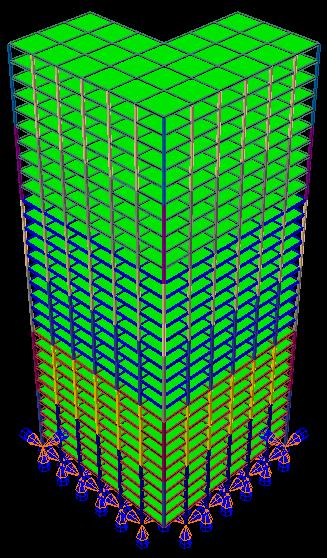
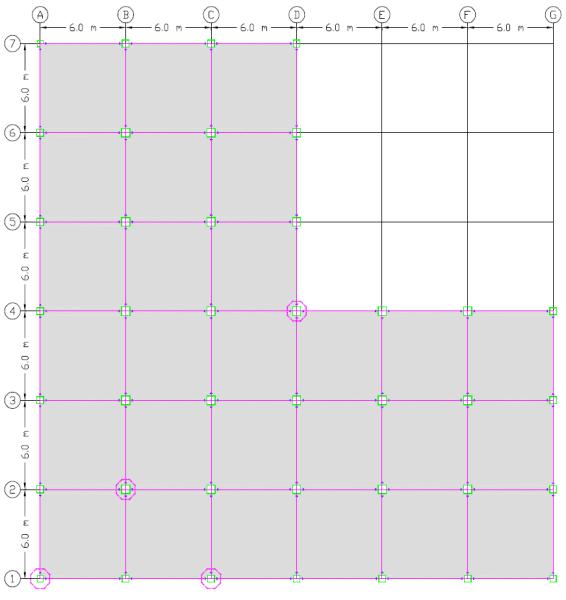
2.4.2. Concrete Material Properties
The concrete material was modelled using a concrete damage plasticity model from Abaqus for slab shell elements. Inelastic behaviour of concrete is presented via isotropic damaged elasticity concept along with compressive plasticity and the isotropic tensile, as shown in Fig. 4. The compressive yielding curve was taken as that of a typical concrete from ACI 332-08 [21]. The parameters for CDP model other than damage variables are shown in TABLE III. The concrete has a density of 2500 Kg/m³ and an elasticity module of 22.1 GPa. The Poisson ratio for concrete has been considered as 0.2.
International Journal of Civil and Structural Engineering Research ISSN 2348-7607 (Online) Vol. 10, Issue 1, pp: (99-109), Month: April 2022 - September 2022, Available at: www.researchpublish.com
Fig. 3. Stress–strain relationship of steel material [20]
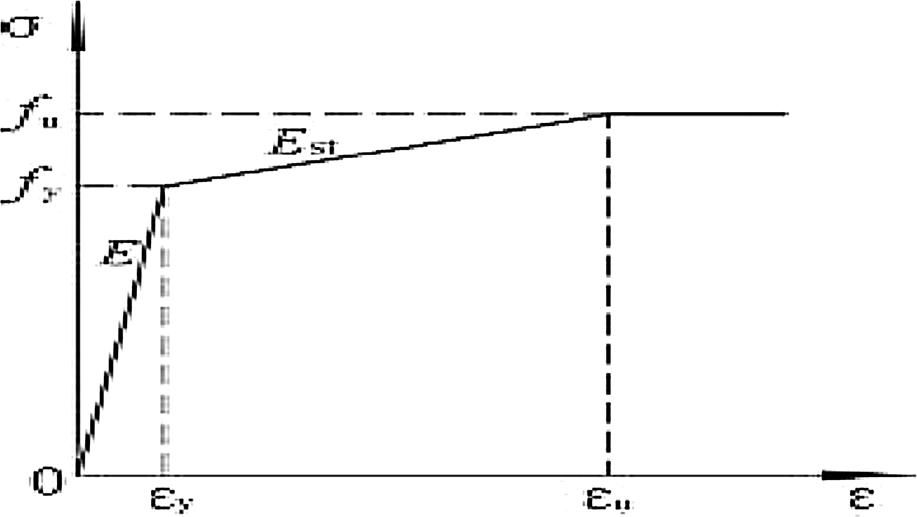
TABLE I: Member sections sizes tf (mm) tw (mm) bf (mm) d (mm) Section Floor 14.6 13.5 12.7
1-5 6-10 11-15 16-20 21-25 26-30
IPE 450 IPE 400 IPE 360
SHS 450*22 SHS 450*18 SHS 400*14 SHS 350*12 SHS 300*10 SHS 250*8
450 400 400
450 450 400 350 300 250
190 180 170
450 450 400 350 300 250
9.4 8.6 8.0
1-10 11-20 21-30 Beams 22 18 14 12 10 8
22 18 14 12 10 8
Corner columns 30 25 22 18 14 10
1-5 6-10 11-15 16-20 21-25 26-30
SHS 500*30 SHS 500*25 SHS 450*22 SHS 450*18 SHS 400*14 SHS 350*10
500 500 450 450 400 350
500 500 450 450 400 350
30 25 22 18 14 10
Edge columns 30 25 22 16 14 10
Interior columns
1-5 6-10 11-15 16-20 21-25 26-30
SHS 600*30 SHS 600*25 SHS 500*22 SHS 500*16 SHS 400*14 SHS 400*10
600 600 500 500 400 400
600 600 500 500 400 400
TABLE II: Material properties of the steel used in the study
Ultimate stress (MPa) Yield stress (MPa) Density (kg/m³) Steel material
30 25 22 16 14 10
Rupture strain Yield strain Elasticity modulus (MPa)
0.018 0.0018 200000 500 345 7850 ASTM A572
TABLE III: Concrete damage plasticity (CDP) model values Parameter Dilation angle (°) Eccentricity fbo=fco k Viscosity parameter Value 36 1 1.16 0.667 0.1
International Journal of Civil and Structural Engineering Research ISSN 2348-7607 (Online) Vol. 10, Issue 1, pp: (99-109), Month: April 2022 - September 2022, Available at: www.researchpublish.com
a) Compressive relationship
b) Tensile relationship
Fig. 4. Stress–strain relationship of concrete [20]
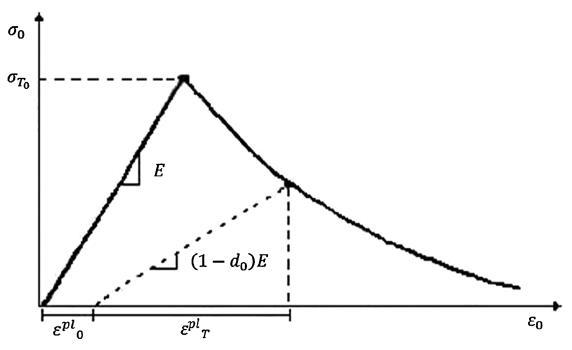
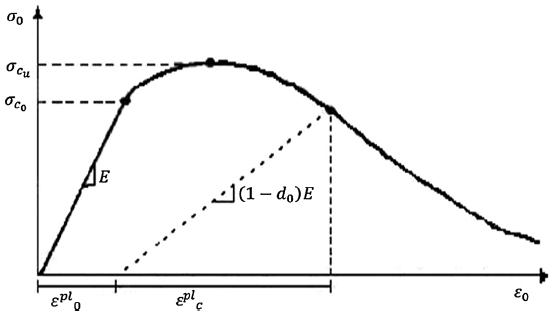
3. VALIDATION OF FINITE ELEMENT MODEL
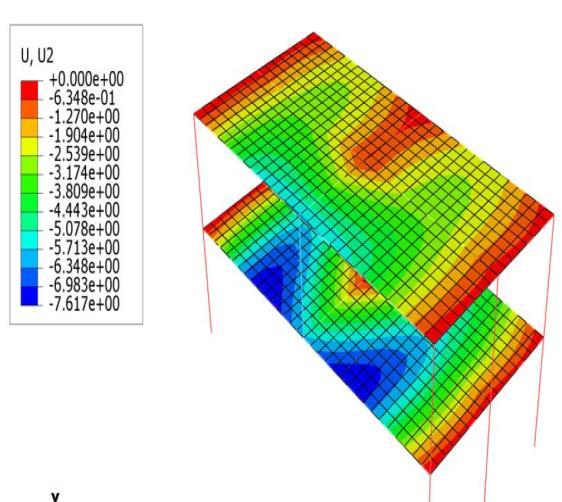
Numerical model for a two-bay two-story 3D steel–concrete composite frame subjected to sudden column removal tested and numerically validated by Junling et al. [15] was used herein to validate the ability of the numerical model to study the progressive failure analysis under column removal scenarios. The bay length in the longitudinal and transverse directions was 4.0 and 2.0 m, respectively, with a uniform story height of 2.0 m. Sections of columns, transverse beams, and longitudinal beams are of H-shape and the section dimensions are given in TABLE IV. The slab thickness was 130 mm thick from the top of the concrete slab to the bottom flute and the rebar were distributed in both directions at 150 mm spacing. The columns and transverse beams were made of Q235B steel with yielding stress (Fy = 235 MPa) and the longitudinal beams were made of Q460 steel with yielding stress (Fy = 460 MPa). The elastic modulus of the steel was 206,000 MPa, the Poisson’s ratio was 0.3. The cast-in-place concrete slabs were C40 (with a yielding capacity of 40 MPa) concrete was cast to form the concrete slabs. The damping ratio was taken as 3.5%.
TABLE IV: Steel member sections dimensions
Section Name
Section depth D (mm)
Section width B (mm)
Thickness (mm) Web Flange
Column 150 150 7 10
Transverse beams 150 75 5 7
Longitudinal beams 200 125 6 8
The experimental test setup is shown in Fig. 5. and the loading values were described in detail by Junling et al. [15], and therefore are not repeated herein for brevity. The deformed shape view in the vertical direction of the 3D composite building after column removal is displayed in Fig. 6. which present that the maximum vertical displacement was 7.62 mm which is in a good agreement with the data obtained by Junling et al. [15] either experimentally or numerically. Where, the maximum vertical displacement of the experimental test was 4.9 mm and the corresponding value obtained in the numerical model developed by Junling et al [15] using Ansys software was 7.4 mm.
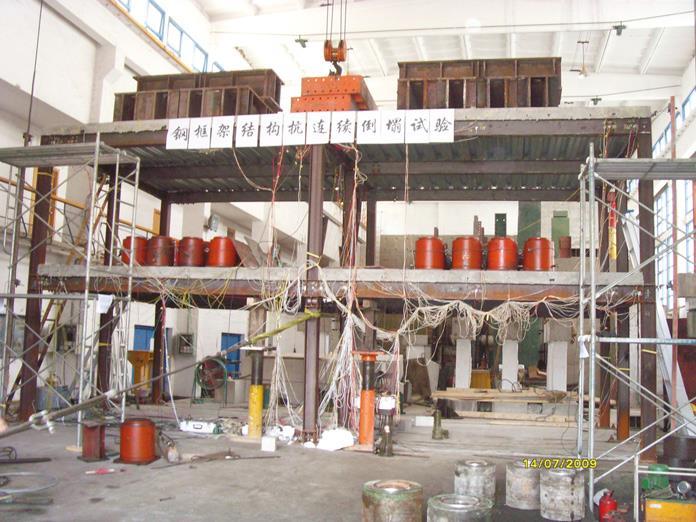
International Journal of Civil and Structural Engineering Research ISSN 2348-7607 (Online)
Vol. 10, Issue 1, pp: (99-109), Month: April 2022 - September 2022, Available at: www.researchpublish.com
4. NONLINEAR DYNAMIC ANALYSIS UNDER DIFFERENT COLUMN REMOVAL SCENARIOS
4.1. Types of progressive failure analysis
Progressive failure is an essentially dynamic event; sudden loss of a column releases significant internal energy that disturbs the initial load equilibrium of external loads and internal forces, which need to be absorbed by the ductile elements of the remaining structure in order for the structure to reach a new equilibrium position, otherwise it will failure. So, in this research, nonlinear dynamic analysis procedure is used to obtain accurate and realistic results. According to GSA (2003), for dynamic analysis purposes, dead loads plus 25% of live loads are applied downward to the structure. The loads were applied to the floors in the form of two types; total dead load and live load. The total dead load (DL) in all floors except roof was applied as 5.0 kN/m² and the live load (LL) is 2.5 kN/m². While, the total dead (DL) for roof was applied as 4.0 kN/m². The roof live load (DL) is 1.0 kN/m². Meanwhile, uniformly distributed load resulted from walls on the building peripheral beams was considered as 7.0 kN/m. The roof wall load was applied as 3.0 kN/m on the peripheral beams only represents the parapet load
4.2 Case studies of column removal scenarios
The common column removal is located in the ground floor, as that induced the most critical conditions concerning structural stability. Additionally, a range of column-removal scenarios have been identified in order to induce meaningful configurations of failure. In each of these scenarios, a column is suddenly removed, and the response of the structure is examined through non-linear dynamic analysis. The columns selected for removal are shown in TABLE V.
4.3. Cases of columns removal at same story level
Fig. 7 to 10 presents the vertical displacement of the node above the removed column at the selected locations in different stories scenarios. In these positions, it can be observed that after the column is suddenly removed, the displacement of the node on the top of the column reaches a peak value due to the sudden loss of the column and subsequently begins to vibrate until it reaches a steady state. From Fig. 7 to 9 it is clear that the vertical displacement of the interior column (2B) at any time of loading is larger than those of columns (1A), (4D) and (1C) at 1st story, 11th story and 21th story. Meanwhile, although the axial force of the internal column (2B) is much larger than that of edge column (1C) and corner columns (1A) & (4D), the vertical displacement of the node above the interior column (2B) is close to that of columns (1A), (4D) and (1C). It is because that after a column is removed, the number of members adjacent to column (2B) is more than edge column (1C) and corner columns (1A) and (4D) which means there are many members to participate the redistribution of internal force of the interior column (2B). But at 30th story, in contrast to the cases of column removal at lower stories it is noticeable in Fig.10 that the node above the corner column (1A) at any time of loading has large value of deformation compared with those of columns (1C), (4D) and (2B). It can be interpreted that although the axial force of the corner column at the 30th story is much smaller than those of columns (1C), (4D) and (2B), the corner column at the 30th story is much more likely to trigger local collapse, due to fewer structural members participating in energydissipation and loss more redundant members than edge column as well as interior column at the same story.
TABLE V: Column removal scenarios
Plan location of removal column Scenario number Y-axis X-axis
Scenario notation Story
I-1A1 1 A 1 1
I-1C1 1 C 1 2 I-2B1 1 B 2 3
I-1A11 11 A 1 4 I-1C11 11 C 1 5 I-2B11 11 B 2 6 I-1A21 21 A 1 7 I-1C21 21 C 1 8 I-2B21 21 B 2 9
I-1A30 30 A 1 10 I-1C30 30 C 1 11 I-2B30 30 B 2 12
I-4D1 1 D 4 13
I-4D11 11 D 4 14 I-4D21 21 D 4 15 I-4D30 30 D 4 16
International Journal of Civil and Structural Engineering Research ISSN 2348-7607 (Online)
Vol. 10, Issue 1, pp: (99-109), Month: April 2022 - September 2022, Available at: www.researchpublish.com
Time ( Sec. )
0 0.0 0.5 1.0 1.5 2.0
-10
Vertical Displacement (mm)
-20
-30
-40
Time ( Sec. )
Vertical Displacement (mm)
-50
-60
-70
-80
Vertical Displacement (mm)
-130 -120 -110 -100 -90 -80 -70 -60 -50 -40 -30 -20 -10 0 0.0 0.5 1.0 1.5 2.0
Fig.7 Displacement of the node above the removed column in the 1st story Fig.8 Displacement of the node above the removed column in the 11th story
Time ( Sec. )
0 0.0 0.5 1.0 1.5 2.0
-20
-40
-60
-80
-100
-120
I-1A1 I-1C1 I-2B1 I-4D1 -160
Time ( Sec. )
-140
4.4. Cases of column removal at different story levels
Vertical Displacement (mm)
I-1A11 I-1C11 I-2B11 I-4D11 -550 -500 -450 -400 -350 -300 -250 -200 -150 -100 -50 0 0.0 0.5 1.0 1.5 2.0
Fig.9 Displacement of the node above the removed column in the 21th story Fig.10 Displacement of the node above the removed column in the 30th story
Vertical Displacement (mm)
Time ( Sec. )
I-1A1 I-1A11 I-1A21 I-1A30
I-1A21 I-1C21 I-2B21 I-4D21 -550 -500 -450 -400 -350 -300 -250 -200 -150 -100 -50 0 0.0 0.5 1.0 1.5 2.0
Vertical Displacement (mm)
For all cases of column removal scenarios, the vertical displacement time history for the node above the removed columns is displayed in Fig. 11 to 14 Fig.11 displays the vertical displacement of the node above the removed corner column (1A) at the 1st story, 11th story, 21th story and 30th story. The maximum displacement of the node above the removed corner column (1A) is 501 mm at the 30th story which is much larger than that at the other scenarios at the lower stories. Also, it is clear that the remaining structure after removing the corner column at the 30th story vibrates more severely than that after removing the corner column at the 1st story, 11th story and the 21th story.
Time ( Sec. )
0 0.0 0.5 1.0 1.5 2.0
-20
-40
-60
-80
-100
-120
-140
I-1C1 I-1C10 I-1C20 I-1C30
I-2B30 I-1C30 I-1A30 I-4D30 -160
Fig.11 Displacement of the node above the removed corner column (1A) Fig.12 Displacement of the node above the removed edge column (1C)
International Journal of Civil and Structural Engineering Research ISSN 2348-7607 (Online) Vol. 10, Issue 1, pp: (99-109), Month: April 2022 - September 2022, Available at: www.researchpublish.com
Time ( Sec. )
0 0.0 0.5 1.0 1.5 2.0
-20
Vertical Displacement (mm)
-40
-60
-80
Time ( Sec. )
0 0.0 0.5 1.0 1.5 2.0
-20
-40
-60
-80
Axial force (kN)
-100
-120
-140
-160
-180
Vertical Displacement (mm)
-100
-120
-140
-160
Fig.13 Displacement of the node above the removed interior column (2B) Fig.14 Displacement of the node above the removed edge column (4D) Fig. 12 to 14 shows the vertical displacement of the node above the removed edge (1C), interior (2B) and the corner (4D) columns respectively at the 1st story, 11th story, 21th story and 30th story. For both edge and interior column removal, the 30st story is also more potential to initiate collapse than the columns at the lower stories where, the maximum displacement of the node above the removed edge column (1C), interior (2B) and the corner (4D) at the 30th story is 142, 156 and 151mm respectively. Due to spatial effect, catenary action, and more members dissipating energy, the vertical displacement of the node above the removed interior column is smaller than that of the removed corner column (1A). Fig. 15 to 18 shows, the axial force in the adjacent critical columns before and after the removal of columns (1A), (1C), (2B) and (4D) from 1st story. As it illustrated in TABLE VI. Fig. 15 shows that the critical column after the corner column (1A) removal is the adjacent edge column (1B1 or 2A1) where the increase in its axial force is 41.50 %. While, the effect of the corner column (1A) removal is insignificant for the rest adjacent columns. Where, the increase in axial force in the adjacent interior column (2B1) and the next adjacent edge column (1C1 or 3A1) is 5.02 % and 2.81 respectively. Fig. 16 displays that the critical column after the edge column (1C1) removal is the adjacent edge column (1B1 or 1D1) and the adjacent interior column (2C1) the where the increase in their axial force is 46.04 % and 30.80 % respectively. While, the effect of the edge column (1C1) removal is less for the rest adjacent columns. Where, the increase in axial force in the adjacent interior column (2B1 or 2D1) is 7.77 %.
Time ( Sec. )
I-1B1,2A1 I-2B1 I-1C1,3A1
I-2B1 I-2B10 I-2B20 I-2B30 -11000 -10000 -9000 -8000 -7000 -6000 -5000 -4000 -3000 -2000 -1000 0 0.0 0.5 1.0 1.5 2.0
Axial force (kN)
Time ( Sec. )
0 0.0 0.5 1.0 1.5 2.0
-2000
-4000
-6000
-8000
-10000
-12000
I-4D1 I-4D11 I-4D21 I-4D30 -14000
I-1B1,1D1 I-2B1,2D1 I-2C1
Fig.15 Axial force time history for the adjacent columns of corner column (1A1) Fig.16 Axial force time history for the adjacent columns edge column (1C1)
International Journal of Civil and Structural Engineering Research ISSN 2348-7607 (Online) Vol. 10, Issue 1, pp: (99-109), Month: April 2022 - September 2022, Available at: www.researchpublish.com
Time ( Sec. )
0 0.0 0.5 1.0 1.5 2.0
-2000
Axial force (kN)
-4000
-6000
-8000
-10000
-12000
-14000
force (kN)
Axial
-2000
-4000
-6000
-8000
-10000
-12000
Time ( Sec. )
0 0.0 0.5 1.0 1.5 2.0
I-5D1,4E1 I-5C1,3E1 I-4C1,3D1 I-3C1
I-1A1 I-1B1,2A1 I-1C1,3A1 I-2C1,3B1 I-3C1 -16000
-14000
Fig.17 Axial force time history for the adjacent columns of interior column (2B1) Fig.18 Axial force time history for the adjacent columns edge column (4D1)
Fig. 17 illustrates the effect on the adjacent columns after interior column (2B1) removal. The most critical column is the adjacent edge column (1B1 or 2A1) with an increase in its axial force of 42.04 %. But, the effect on the corner column (1A1) as well as the adjacent interior column (2C1 or 3B1) is less where, the increase in their axial force is 23.0 % and 22.32 % respectively. While, Fig. 18 shows the effect on the adjacent columns after corner column (4D1) removal. The most critical column is the adjacent edge column (5D1 or 4E1) with an increase in its axial force of 26.4 %. But, the effect on the interior column (4C1 or 3D1) as well as the adjacent interior columns (5C1 or 3E1) and (3C1) is less where, the increase in their axial force is 16.60 %, 3.44 and 3.65 % respectively.
TABLE VI: Axial force in critical adjacent columns for 1st story removal scenarios
Critical adjacent column Column removal scenario
I-1B1, I-2A1
Axial force in critical adjacent column (kN)
After removal Before removal
Increase in load (%)
41.50 9075 6413
I-1A1 5.02 10256 9766 I-2B1 2.81 7035 6843 I-1C1, I-3A1 46.04 9119 6244 I-1B1, I-1D1 I-1C1 7.77 9792 9086 I-2B1, I-2D1 30.80 11882 9084 I-2C1 23.00 4742 3855 I-1A1
I-2B1 42.04 8869 6244 I-1B1, I-2A1 7.98 7389 6843 I-1C1, I-3A1 22.32 11797 9644 I-2C1, I-3B1 7.57 10784 10025 I-3C1 26.40 10940 8655 I-5D1, I-4E1 I-4D1 3.44 10747 10390 I-5C1, I-3E1 16.60 13745 11788 I-4C1, I-3D1 3.65 11573 11165 I-3C1
5. CONCLUSION
In this paper, a 30-storey building with intermediate moment-resisting frame is established by using the finite element software Abaqus to study the behaviour of high-rise irregular steel building under sudden column loss. The building was designed according to the ASCE [4] and AISC [22]. In order to validate the accuracy of the finite element model, a twostorey 2-bay model is developed to compare with the experimental results. The numerical results are in a good agreement with the experimental results which, validated the accuracy of the finite element model. The proposed model could represent the progressive failure behaviour of high-rise buildings, accounting for the composite action between steel elements and reinforced concrete slab. Using the 30-storey building model, nonlinear dynamic analysis is conducted
International Journal of Civil and Structural Engineering Research ISSN 2348-7607 (Online) Vol. 10, Issue 1, pp: (99-109), Month: April 2022 - September 2022, Available at: www.researchpublish.com
under the column removal scenarios which involves the plane position and vertical position. The results of the analyses reveal that the displacement of the node above the removed column and the axial force of the columns adjacent to the one removed could provide a rational indication of the risk of overall failure of building. It can be concluded that the 30-storey building considering designed to meet American seismic standards have suitable load paths and redundancy to resist the spread of local failure due to sudden column removal. Also, the ability of energy dissipation of remaining structure after a corner column loss is weaker than that after an edge as well as a middle column removal, because there is less spatial effect and members dissipating energy. The columns adjacent to the removed column are the critical columns that affect the redistribution of internal force and should be strengthened.
REFERENCES
[1] Griffiths, H., Pugsley, A., Saunders, O. 1968. Report of inquiry into the collapse of flats at Ronan Point, Canning Town. Ministry of Housing and Local Government. Her Majesty’s Stationary Office. London, United Kingdom.
[2] CORLEY, W. G., SOZEN, M. A., THORNTON, C. H. & MLAKAR, P. F. 1996. The Oklahoma City bombing: improving building performance through multi-hazard mitigation. FEMA report 277: Federal Emergency Management Agency Mitigation Directorate.
[3] Carlos Antonios Vidalis (2014). Improving the resistance to progressive collapse of steel and composite frames. Ph. D. thesis, Department of Civil and Environmental Engineering, Imperial College London.
[4] ASCE. SEI/ASCE 7-10, Minimum Design Loads for Buildings and Other Structures, American Society of Civil Engineers, Washington DC, 2010.
[5] GSA. Progressive collapse analysis and design guidelines for new federal office buildings and major modernization projects. The US General Services Administration; 2003.
[6] GSA. 2013. Alternate Path Analysis and Design Guidelines for Progressive Collapse Resistance. General Services Administration (GSA). Washington, D.C.
[7] Unified Facilities Criteria (UFC)-DoD. Design of buildings to resist progressive collapse. Department of Defense; 2005.
[8] Unified Facilities Criteria (UFC)-DoD. Design of buildings to resist progressive collapse. Department of Defense; 2009.
[9] Astaneh-Asl A. Progressive collapse prevention in new and existing buildings. 2003. p. 1001–8.
[10] NIST. Best Practices for Reducing the Potential for Progressive Collapse in Buildings. Gaithersburg, MD, USA: National Institute of Standard and Technology;2006.
[11] Kim J, Hwang JS. Effect of catenary action on collapse of steel frames. Proceedings of Euro steel. Austria: Graz; 2008.
[12] Khandelwal, K., El-Tawil, S. and Sadek, F. (2009) Progressive collapse analysis of seismically designed steel braced frames. Journal of Constructional Steel Research, 65: (3): 699-708.
[13] Kim J, An D. Evaluation of progressive collapse potential of steel moment frames considering catenary action. Struct. Design Tall Spec. Build. 2009;18:455–65.
[14] Feng, F. (2009) Progressive collapse analysis of high-rise building with 3-D finite element modelling method. J Constr Steel Res, 65: 1269–1278.
[15] Junling, C., H. Xin, M. Renle, and H. Minjuan. 2012. “Experimental study on the progressive collapse resistance of a two-story steel moment frame.” J. Perform. Constr. Facil. 26 (5): 567–575.
[16] Gerasimidis, S., Bisbos, C., and Baniotopoulos, C.C. (2012) Vertical Geometric Irregularity Assessment of Steel Frames on Robustness and Disproportionate Collapse. Journal of constructional steel research, 74: 76-89.
International Journal of Civil and Structural Engineering Research ISSN 2348-7607 (Online) Vol. 10, Issue 1, pp: (99-109), Month: April 2022 - September 2022, Available at: www.researchpublish.com
[17] Homaioon Ebrahimi, A., Martinez-Vazquez, P., and Baniotopoulos C.C. (2017) Numerical studies on the effect of plan irregularities in the progressive collapse of steel structures. Structure and Infrastructure Engineering, 13: (12):1576-1583.
[18] Liu-Lian Li, Guo-Qiang Li, Binhui Jiang, Yong Lu, Analysis of robustness of steel frames against progressive collapse, J. Constr. Steel Res. 143 (2018) 264–278.
[19] ABAQUS, ABAQUS/standard, Version 2017, ABAQUS, Inc., Pawtucket, R.I, 2017.
[20] Rohola Rahnavarda, Faramarz Fathi Zadeh Fard, Ali Hosseini and Mohamed Suleimand (2018) Nonlinear Analysis on Progressive Collapse of Tall Steel Composite Buildings
[21] ACI 332-08, Code Requirements for Residential Concrete and Commentary, American Concrete Institute, 2008.
[22] AISC (2010) Manual of steel construction, American Institude of Steel Construction, Chicago, IL, USA.
